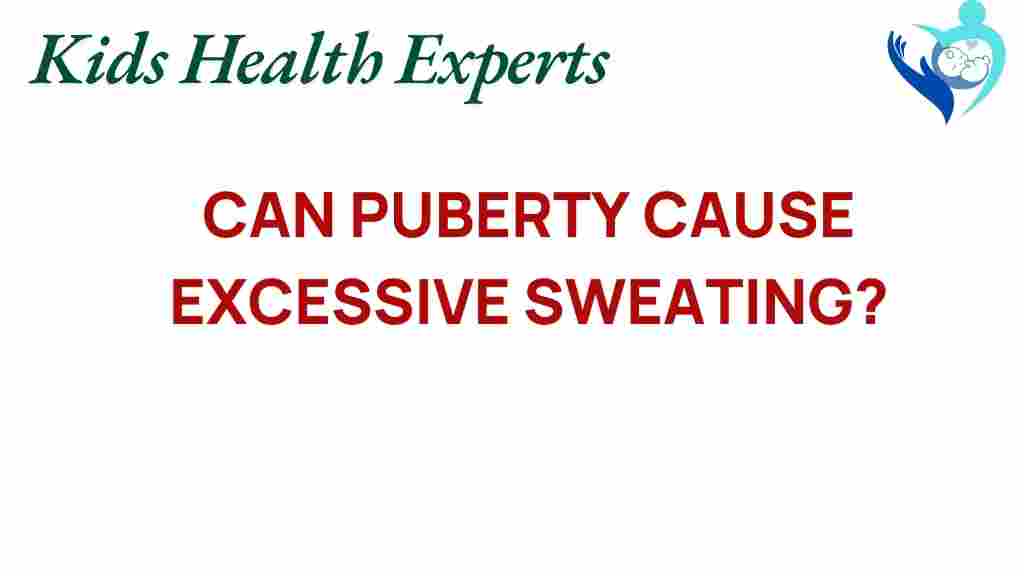Unraveling the Mystery: Can Puberty Trigger Excessive Sweating?
Puberty is a pivotal phase in life marked by significant physical, emotional, and hormonal changes. As adolescents transition from childhood to adulthood, they experience a range of body changes, including the onset of excessive sweating, medically known as hyperhidrosis. This article delves into the relationship between puberty and excessive sweating, exploring the symptoms, health concerns, and the underlying hormonal shifts that contribute to this condition during the teenage years.
Understanding Puberty and Its Impact on the Body
Puberty typically occurs between the ages of 10 and 14 for girls and 12 to 16 for boys. This period is characterized by:
- Growth spurts
- Development of secondary sexual characteristics
- Changes in body composition
- Emotional and psychological shifts
As the body undergoes these transformations, the endocrine system releases various hormones, including estrogen and testosterone, which can significantly impact physiological functions, including sweating.
The Connection Between Puberty and Excessive Sweating
Excessive sweating, or hyperhidrosis, affects many adolescents during puberty. This condition can manifest in several ways:
- Localized sweating (e.g., underarms, palms, feet)
- Generalized sweating (affecting the entire body)
Understanding how puberty triggers excessive sweating involves examining the hormonal changes that occur during this time. The body’s increased production of sweat glands and their heightened sensitivity to hormones can lead to an overactive sweat response.
Symptoms of Excessive Sweating During Adolescence
Symptoms of hyperhidrosis can vary from person to person, but common signs include:
- Profuse sweating in specific areas, such as the armpits, hands, and feet
- Visible perspiration on clothing
- Skin irritation or infections due to prolonged moisture
- Social anxiety or embarrassment due to excessive sweating
These symptoms can significantly impact an adolescent’s self-esteem and social interactions, leading to health concerns if left unaddressed.
The Role of Hormonal Changes in Hyperhidrosis
During puberty, the body experiences a surge in hormone levels. These hormones play a crucial role in regulating various bodily functions, including sweat production. Key hormones involved include:
- Estrogen: Increases sweating in females.
- Testosterone: Affects sweat gland activity in males.
- Growth hormone: Can also influence sweat production.
The fluctuations in these hormones can lead to increased activity of the sweat glands, resulting in excessive sweating. This condition may persist into adulthood for some individuals.
Health Concerns Related to Excessive Sweating in Teenagers
Excessive sweating during the teenage years can lead to various health concerns, including:
- Skin Issues: Prolonged moisture can cause skin irritation, rashes, or fungal infections.
- Emotional Distress: Teenagers may experience anxiety, depression, or social withdrawal due to embarrassment.
- Impact on Daily Life: Excessive sweating can interfere with school activities, sports, and social events.
It is essential for parents and guardians to recognize these concerns and seek appropriate medical advice if their child is experiencing excessive sweating.
Step-by-Step Process for Managing Excessive Sweating During Puberty
If excessive sweating becomes a concern during puberty, here are steps to manage the condition:
- Consult a Healthcare Professional: Schedule an appointment with a dermatologist or pediatrician to discuss symptoms and potential treatment options.
- Keep a Sweat Diary: Track when and where sweating occurs to identify triggers.
- Use Antiperspirants: Over-the-counter clinical-strength antiperspirants can help reduce sweating. Apply them at night for best results.
- Wear Breathable Fabrics: Choose clothing made from natural fibers that allow the skin to breathe.
- Practice Stress Reduction Techniques: Engage in activities like yoga or mindfulness to manage anxiety, which can exacerbate sweating.
- Explore Medical Treatments: In severe cases, treatments such as prescription antiperspirants, iontophoresis, Botox injections, or medications may be considered.
Addressing excessive sweating early on can help mitigate its impact on an adolescent’s quality of life.
Troubleshooting Tips for Adolescents Dealing with Excessive Sweating
Here are some troubleshooting tips for adolescents to manage excessive sweating:
- Stay Hydrated: Drinking water can help regulate body temperature and reduce sweating.
- Stay Cool: Use fans, air conditioning, or cool showers to help manage body temperature.
- Avoid Trigger Foods: Spicy foods, caffeine, and alcohol can trigger sweating. Monitor dietary intake for potential triggers.
- Practice Good Hygiene: Regular bathing and changing clothes can help manage sweat and odor.
These practical tips can help adolescents feel more comfortable and confident during their teenage years.
Conclusion
Understanding the connection between puberty and excessive sweating is crucial for adolescents and their families. As hormonal changes trigger various body changes, excessive sweating can become a significant concern. By recognizing the symptoms, exploring management strategies, and seeking professional help when necessary, teenagers can navigate this challenging phase of life with greater ease.
If you or someone you know is struggling with hyperhidrosis, consider consulting a healthcare provider for tailored advice and treatment options. For further information on hyperhidrosis, you can visit this resource.
Remember, puberty is a natural part of life, and tackling health concerns like excessive sweating can lead to a more confident and enjoyable adolescence.
This article is in the category Conditions and created by KidsHealthExperts Team
